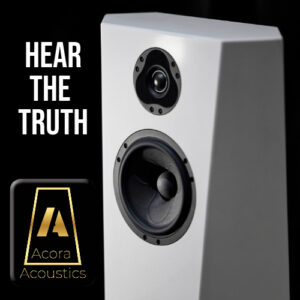The Introduction: Vivid Audio Giya G4 S2
Outside of the Paddington Station west entrance there is a man inside the face of a clock, and every minute he wipes away the minute hand and paints a new one in its place – watch him long enough and you’ll even see the hour hand replaced. I have stared at the man in this clock for several weeks now, and though I do not know its intended significance, he has accompanied many a late night walk home from the Paddington Elizabeth Line tube stop.
Not too far away, just across the Little Venice Canal from Paddington, I passed by Abbey Road Studios, which on this particular Thursday evening was a hub of quiet freneticism. Three men in leather jackets, smoking outside, gave me a nod as I made my way to the nearby bus stop. As I made a mental note to stay on the lookout for a new Oasis album, I noticed a certain easy, unhurriedness in their posture. These were not first-timers, and unlike myself they had no destination other than where they were standing—they had all the time in the world.
Words and Photography by Grover Neville
In contrast to my thoughts on the SW1X DAV IV Special, a piece which was written on the train from Amsterdam to London, I write this particular piece about a South African company, while seated kilometers under the ocean on a Eurostar train back to Amsterdam. One thought had while greeting England, another had while leaving it, both mirrors of the other.
Vivid Audio, is nothing if not a mirror of SW1X. Laurence Dickie (founder) is a native of the British Isles, and is well known for being the mind behind the Bowers & Wilkins Nautilus project—the famous blue ‘Super Snail’ that still gets trotted out by that company from time to time. He has since taken his knowledge and created an entire new lineup which includes the Kaya and Giya lines— the latter of which is the subject of this particular piece. In this case however, Vivid Audio is that South African company, an inversion of northerly expectations in an audiophile world thought to only inhabit the spaces under a halo of the boreal zone.

Vivid Audio Giya G4 S2
The inversions, like Bach, don’t stop there. Vivid’s graceful, organic lines and design work are in stark contrast to the traditional cherry-clad ply we think of when calling to mind Harbeth, Spendor, LS3/5a—british speakers. These are no Brit-Fi speakers however. This is international, avant-garde design at its finest, mated with high-end technology. While Dickie’s work at B&W on the Nautilus was beautiful, the work he is doing currently with Vivid has advanced well beyond it in both looks and design. Step aside Blighty, enter Johannesburg.
Bill Parish and the folks at GTT Audio who distribute Vivid in the states or Mr. Dickie himself could detail the exact functions of some of those graceful curves—the little curlicue that graces the top of all the Giyas for example is more than simply a design flourish, but instead an artfully incorporated acoustic solution.

I’ll point you towards Vivid’s delightfully named ‘Technical Overture PDF’ for all the gory details, but suffice to say, these are seriously high-tech beasts. Drivers are completely customized in sophisticated ways, the cabinets themselves are designed to be light yet rigid unlike the hefty metal cabinets of some competitors, and solutions for resonance control often involve clever magnet and structural design, which goes for elegant rather than the brute force damping approach employed by so many these days. Lauren Dickie and the folks at Vivid are clearly not first-timers.
(Link: https://vividaudio.com/downloads/Vivid-Audio_Technical-Overture.pdf)

The Set-Up: Vivid Audio Giya G4 S2
The unit I received, the Vivid Giya G4 S2 is the smallest and most affordable of the Giya range, though it is not diminutive by any means. Dick Diamond from GTT was kind enough to come out and help set them up in my loft in Santa Monica, and the entire experience was one of the most pleasant and best thought-out of any hi-fi component I’ve reviewed. The speakers ship in a single, pallet-crate, and are bolted in securely. Removal requires some tools, but is a simple and painless affair.
I have to give Dick and the folks at GTT a shout-out here, as this is my third time reviewing a component from them, and they truly are some of the friendliest, most organized and unpretentious people I’ve worked with. They are consistently on-time, responsive and enjoy a wide variety of music and conversational topics. I haven’t got a single complaint about any interaction I’ve had with them. GTT always makes me feel as if we have all the time in the world.
Well… almost. I do wish I’d gotten to review a pair of Giyas in one of the more adventurous colors like Hot Pink, Oyster Matte Yellow or Lime Green. Alas. What I received was still a very attractive pair, finished in a pearlescent white, which I suppose those with less adventurous tastes than myself will find properly respectable.
Setup is a simple affair, which took little time to get good. The trickiest part is not moving the speakers, which are surprisingly light due to that glass-fibre composite material, but rather getting the speaker cables on. With the G4, the speaker terminals are accessed through the rear-most bottom of the speaker, set in somewhat deeply, which necessitates either of two scenarios: lying the speaker down to the floor, or having a second person tip the speaker body fairly far forward. The speaker’s lack of hard edges makes this a two hand job.

The Sound: Vivid Audio Giya G4 S2
Once the cables are attached, the bottom plate cleverly hides and manages the cables, though anyone with a disposition towards constant speaker-cable swapping may find the process a little challenging to perform regularly. Oh, and I should mention: banana plugs are by far the better option here. After this, the magnetic grilles simply pop into place.
What greets me on first listen is quite unlike anything I’ve heard before. Forget the questionable gimmicks of Dolby Atmos, if you have just a pair of these Giya speakers, the perception of stereo recorded space is effortless and enormous, both wide, deep and with a certain smoothness of texture that makes it hard to pinpoint any kind of obnoxious coloration. I would not say it is warm exactly, as the level balance seems appropriate, but the quality of the mid and high ranges is devoid of the hard, brittle and forward sound that many heavily-damped, very expensive dome-tweeter speakers have tended towards for several years now.
Our INDULGR Audiophile playlist includes 600+ tracks perfect for auditioning high-end audio gear, and was curated by our team of editors.
I am reminded of the man in the clock face—every small mesmerizing movement reaching towards the inevitable moving of the hands. The Vivid Giya G4 S2 display every tiny movement and detail, yet always in pursuit of the destination of the musical whole, and not as some speakers do in a buffet style where everything is served up equally, with no sense of musical organization. Even when I’m fussing with positioning, the Vivids reminded me to pause, and enjoy where I am right here, and right now. ‘You’re already at your destination,’ they remind me.
That said, no matter where I positioned them, the top end sounded excellent, and toe-in was really a matter of taste. If you prefer more razor precision, apply more, if you enjoy a wider, more pillow-y, expansive sound, apply less. Bass on the other hand was a trickier beast.
In certain positions I experienced enormous low end, while in others I struggled to get a quantity I found satisfying. I finally came to the conclusion after much fussing, that the dual-opposing woofers and ports did not enjoy the corners of my listening room. Toeing-in the speakers towards my head, and bringing them a fair bit off the back wall reward me with a rich, dense and surprisingly robust sound below ~80hz. I’ve never had speakers in this particular position in this room, but as they say: do what works.

Another challenge was the efficiency of these speakers. At an 86dB listed sensitivity, these speakers most certainly were not a match for the modestly-powered tube amps I typically enjoy. Beefy solid state from brands like Alluxity and Mark Levinson were the order of the day, and it was with these that I listened most during the review period.
When it comes to time spent listening, I look most especially for a purity and coherency of musical presentation. I care little for experiences which speak to facile technical capabilities, or the analytical brain. I want music to sound irresistible at every listen—there isn’t time in life for anything less. The Giya G4 S2 is the kind of speaker which may be able to do a bit of both.
There is purity in the Giya’s sound, and it has a trait many properly high-end speakers do, wherein the sound has a noticeable lack of any identifiable, objectionable coloration. They simply let music come forth, and in the case of the vivid do it with relaxed precision. The entire music picture is coherent and unhurried, even if you decide to play something from the Oasis discography.
The midrange and treble of the Vivid Audio Giya G4 S2 are amongst the purest, sweetest and most enjoyable I’ve ever heard, and are perhaps reason enough to purchase these. The low end is textured and plentiful, though occasionally I felt I’d heard speakers with more speed or dynamic slam—not a knock on these, simply that those who demand damped, clinically precise bass and an awful lot of it may find something more to their tastes elsewhere.

 The Conclusion: Vivid Audio Giya G4 S2
The Conclusion: Vivid Audio Giya G4 S2
After I had some time to digest my initial impressions and really dig deeper with the Vivid Audio Giya G4 S2, it occurred to me that despite the exotic looks and technologies, these are in many ways a quintessentially British loudspeaker, yet also… not. They do not offend, they play smooth, easy and precise. Low end is present but not overwhelming and the sweet and delicate midrange is the focus of the presentation. All traits I think of when I think of the most admired Brit-fi. True to the international heritage of Vivid however, these have been polished, preened, and gone through Hyperdrive to land on Kamino. What remains is something that exists as a sonic objet d’art, that is one hundred percent blood and born of Laurence Dickie, and to my ears, an offering at the church of the art and music lover.
From Amsterdam to London, and now back again, much like the journey from Abbey Road to the Nautilus, to Vivid, time and destination are always the critical questions. Though the Vivid Audio Giya G4 S2 speakers have since left, the time I spent with them remains stamped in my mind and senses. At their price point, a price which represents a sort of first gateway to the truly high-end, they have one carbon-fibre base (per channel) firmly planted in the realm of—dare I say it—summit-fi.
Like the man in the clock, the Vivid Audio Giya G4 S2 speakers accompanied many a contemplative late night, and at their best I was similarly transfixed. From his roots in the Northern Hemisphere to the Southern, and the multitudinous heritage and artistry, Laurence Dickie has landed at a perspective as unique as any I’ve found in audio and beyond. As I land on Amsterdam’s doorstep once again, I feel most acutely that which I am not: unhurried, expectation-less, destination-less. I am present, and my destination is where I am right now—a realization made firmer, more concrete, more real with the Giyas. The magnitude of precision it takes to make an object which can help us locate ourselves in space or time, is enormous. It requires designers to give of themselves, and I believe Mr. Dickie has done a very fine job of this task indeed.
About the Author
Wanderer, Wonderer, Musician, Actor
Grover Neville resides in sunny Los Angeles, California, and is a graduate of the Oberlin Conservatory of Music where he studied music and creative writing. After graduating he pursued a freelance career in audio, and professional research in the fields of Auditory Cognition, Psychoacoustics, and Experimental Hydrophone Design. He is a native of Chicago, Illinois and previously did work there as a mixing and mastering engineer, working in music genres such as Avant-garde Classical and Jazz.
As a transplant to Los Angeles, Grover still works in the music industry, but now adds the video game and film industries to his calling. He is actively pursuing a career as an independent musician, composer, and producer. He previously contributed to Innerfidelity, Audiostream, and Part-Time Audiophile—before becoming an editor and co-founder of INDULGR magazine.





































